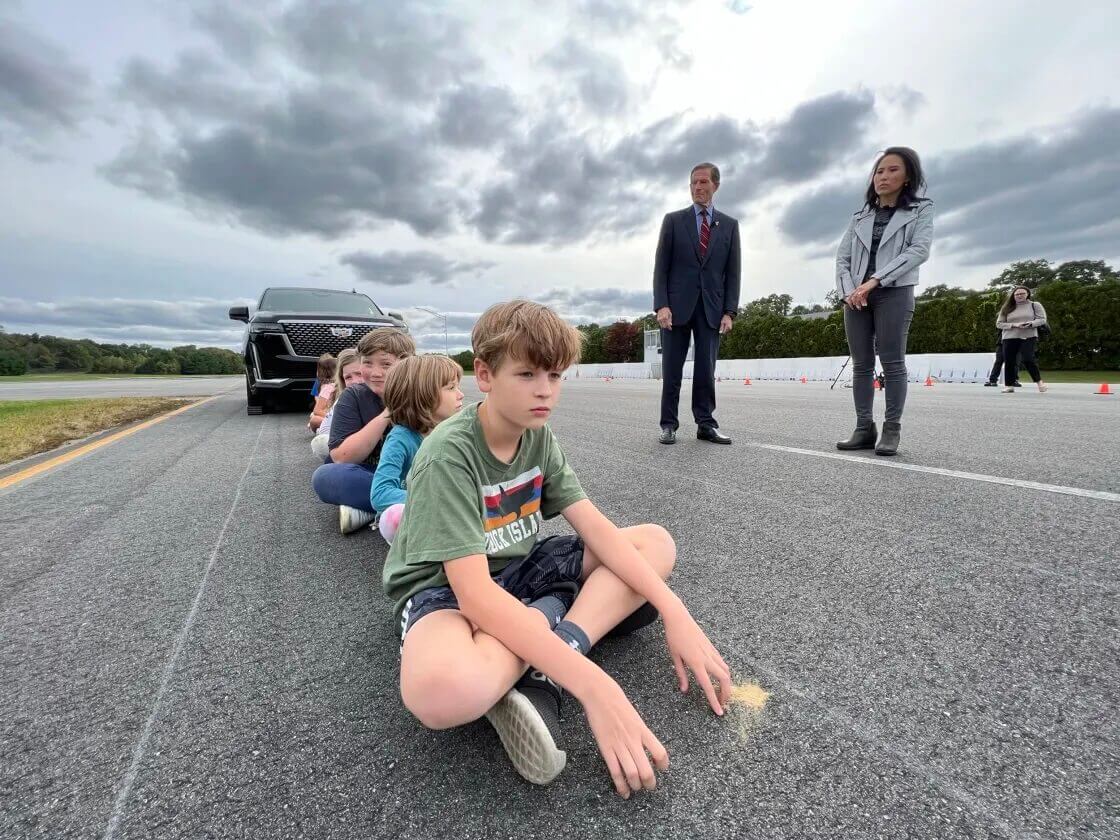By , , and
The day after Christmas 2016, Jenesee Beaudoin was moving her SUV in her parents’ San Antonio driveway, preparing to pack up her children’s presents, when she felt something under her wheels.
“It felt like I went off a curb,” she said. As she opened the car door to see what happened, her son began screaming his younger sister’s name from the doorway. “I ran to the back of my car and there she was in between my back tires.”
Beaudoin had left Briley, 2, in a living room full of adults. But once in the driver’s seat, she had no way to see that her daughter had wandered outside after her — right into the SUV’s front blind zone as she started the engine.
Briley died hours later at a hospital.

Briley Beaudoin. Photo courtesy of Jenesee Beaudoin.
“I had a backup camera, but I wasn’t going backwards,” Beaudoin said. “It took seconds. It’s literally seconds and someone’s life is changed forever.”
Briley was one of an estimated 64 children who died that year after being hit by a forward-moving vehicle off of public roads, according to an NBC News analysis of federal crash data. More than twice as many children have died from such crashes when vehicles were moving forward than backward in recent years. An estimated 744 children were killed that way from 2016 to 2020, mostly in driveways and parking lots. In the majority of deaths, the child was hit by an SUV or a pickup truck.
Those numbers rose sharply in 2020, and advocates worry they will continue to rise, as Americans increasingly buy large vehicles with big front blind zones, instead of smaller cars with greater visibility.
Front cameras could help prevent these deaths, safety experts say. New vehicles sold in the United States are required to have a backup camera for rear visibility, but no such regulation exists for front blind zones. While some vehicles do come standard now with front cameras, or with front sensors that can detect obstacles and may prevent accidents, they are often expensive or luxury vehicles.
But front blind zones can extend a dozen feet or more for some of the country’s most popular vehicles, according to Consumer Reports, much further than drivers may realize. In a demonstration at the Consumer Reports Test Track in Connecticut, NBC News found it took at least nine elementary school children sitting in a line for someone in the driver’s seat of four different SUVs and pickup trucks to see the top of a single child’s head.
“I wouldn’t have believed it without doing this test. But I’m amazed, I’m appalled,” Sen. Richard Blumenthal, D-Conn., who has championed safety legislation, said after participating in the demonstration.
On Monday, he announced legislation that would make front blind zone safety features mandatory for motor vehicles. Automakers said safety is a top priority for them and those features are increasingly available already.
“Safety should not be a matter of affordability, safety ought to be standard, and these devices can save kids’ lives,” Blumenthal said. “We ought to require them.”
Taller and heavier
Even if Blumenthal’s bill could be passed immediately, it might be two decades before those safety features are commonplace in vehicles.
After Congress passed a law to improve rear blind zone safety nearly 15 years ago, it took a decade — rulemaking, regulatory delays and a multiyear rollout — before it fully went into effect. The average passenger vehicle in the country is 12 years old, so it will still be years before the vast majority of cars on the road have backup cameras.
That 2008 law also directed the National Highway Traffic Safety Administration to begin publishing data on nontraffic crashes — those that happen not on public roadways, but in places such as driveways and parking lots.
That data showed that over the past 13 years, estimated deaths from forward-moving vehicles outnumbered backward-moving vehicle deaths in most years. And in the most recent five years that data was available, forward-moving deaths climbed, while backward-moving deaths stayed relatively flat.
Blumenthal’s bill directs regulators to determine what technology, such as cameras or sensors, to require to make front blind zones safer, much like the rear blind zone law did.
“It’s hard to understand why we’ve known this is a problem for so long, and we’ve had this solution sitting on a shelf that’s not being used everywhere in every car,” said Amber Rollins, director of Kids and Car Safety, an advocacy group that has been pushing for rear and front blind zone protections for decades. “There’s a solution out there, and yet families continue to bury their children.”
Kids and Car Safety has tracked its own data for years on blind zone deaths, known as frontovers and backovers, gathered from news stories, police reports and firsthand accounts. Rollins has seen fewer reports of backover deaths in the years since the rule went into effect, but more frontovers, in part, she suspects, because more people are driving large vehicles.
American car buying habits have changed dramatically in the past decade. Cars make up less than half the market share they did a decade ago, while SUVs now account for half of all new vehicles sold in the U.S. Front visibility can be quite good for subcompact, compact and even some midsize SUVs, experts said. But generally, the taller and heavier the vehicle, the more limited the front visibility — and Americans are buying bigger vehicles than they used to.
Every category of midsize or larger SUVs and pickup trucks saw more than 20% growth in market share from 2012 to 2021, according to an NBC News analysis of Edmunds data. The most purchased new vehicle in the country for more than a decade has been the Ford F-150, a large truck.
“Over time, people prefer trucks and SUVs over cars,” said Brian Moody, executive editor at Kelley Blue Book. They’re increasingly family vehicles, he said, often with larger capacities and more comfort features than the sedans and vans families primarily used to drive. “People who live in suburban and rural areas definitely have more latitude to purchase something that fits their needs, like a large SUV or a pickup.”

.png)


